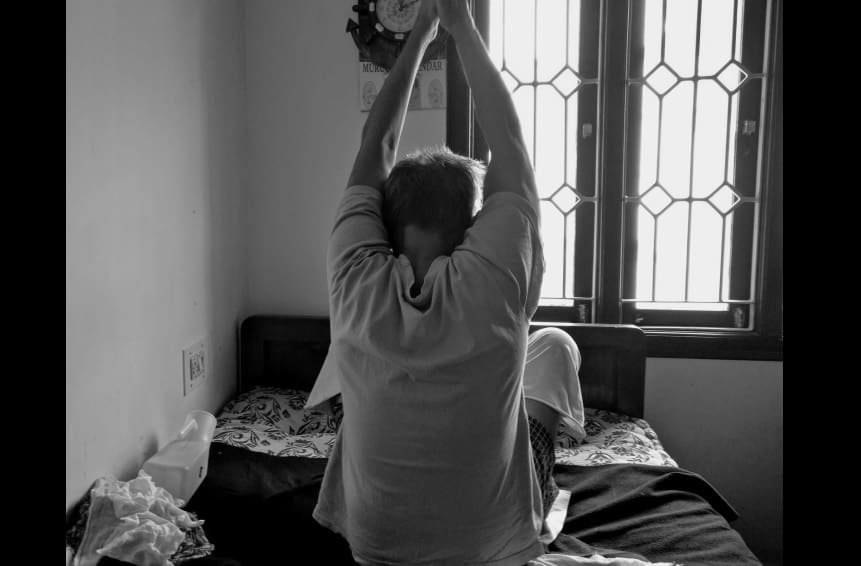At the start of the pandemic in 2020, the National Institute of Mental Health and Neurosciences, Bengaluru, started a national helpline for COVID-related mental health issues. The nature of calls in the second wave are different from those in the first. From psycho-social issues in the first wave, callers are now trying to cope with hospitalisation, death, grief and the like.
Dr K Sekar heads the Centre for Psychosocial Support in Disaster Management, which runs the helpline (080-4611 0007). He reveals that calls had plateaued by March, but are peaking again. “When we started the helpline in March 2020, we got 1-2 lakh calls within the first month itself. The issue then was, how to adjust. During lockdowns, there were calls about lack of rations and jobs, migrants unable to go home, general depression, etc. … that is, the calls were more about social situations.”
Now, in the second wave, it is more about loss of loved ones, not being able to perform their final rites, the helplessness of not finding oxygen or beds, about the elderly left back alone, etc. “There are more calls on mental health issues and severe psycho-social issues now,” says he.
An example is of an 87-year-old man who survived COVID but lost his wife to it. He didn’t wish to live anymore. “Apart from talking to him about the meaning of life etc, we also arranged for a person who would visit him frequently. Now he awaits that person’s visits,” says Dr Sekar. The helpline is currently following up with around 58,000 such patients.

During such calamities, a large section of people would have abnormal reactions, Dr Sekar said. Eventually, however, only about 10% of the population would need long-term care by mental health professionals. “Initially, about 90% of the population would have abnormal psycho-social reactions as we saw in the first wave; thoughts like, ‘who is the government to ask me to sit at home’, `why can’t I go to work’, etc. Now it’s coming down to about 60% of the population who have mental health issues but can’t be diagnosed as having a mental illness per se,” he says .
“Within about a year, the affected population will come down to 30%, that is, people suffering prolonged grief over the severe trauma they suffered. In another year, there would be about 10% who need long-term mental healthcare. This timeline can vary depending on the intensity of the situation.”
Based on evolving evidence from COVID as well as previous experience from SARS and MERS epidemics, this February, the Psychiatry Department at NIMHANS published a document on the possible mental health effects of COVID. The document says a mental health pandemic is looming and that our systems need to be prepared for this. Following are some key pointers from the document.
Widespread anxiety due to COVID
The document says that, in the current scenario of COVID deaths, lockdowns, job losses, etc, anxiety and depression are quite widespread. In most cases, anxiety may not interfere with daily functioning, or would disappear once the stressor is gone. In some other cases though, the mental health problem could interfere with daily life, or cause suicidal thoughts, to the extent that the patient would need treatment by a mental health professional immediately.
Several types of anxiety disorders are expected to increase with COVID. Cases of Generalised Anxiety Disorder (GAD, wherein the person suffers persistent nervousness, irritability, poor concentration, sleep disturbances, etc), panic disorders (characterised by panic attacks), phobia such as excessive fear of crowds, are expected to appear.
Cases of Obsessive Compulsive Disorder (OCD) are expected to increase with COVID, with distressing obsessions about contamination, and washing rituals that can last hours. Healthcare workers are more vulnerable to this in the current scenario.
Cases of Post Traumatic Stress Disorder (PTSD) are also expected to arise due to COVID. The NIMHANS document cites a study that found 7-9% prevalence of PTSD among those living in areas hit hard by COVID.
Read more: Relieving pandemic-related stress through art
The document points out that worldwide, increased suicide rates are also being reported during COVID. Severe COVID infection, losing family members, losing jobs and livelihood, having a mental illness, are among the risk factors for suicide. Substance use (mostly tobacco and alcohol) to deal with isolation and stress is also expected.
During COVID, besides recognised mental health conditions, many new factors have emerged as ‘life events’ – that is, social experiences that have an impact on the individual’s mental health. These include COVID diagnosis for oneself or family members, lockdown, migration, work-from-home, online education, etc., which have never been on any rating scale. These factors should be considered, says the document.

“Normally we may have 2-3 life events a year; for example, having fever for a week and recovering. But now, people are going through multiple life events in a short period. Also, their family, society, community are all being challenged at the same time,” says Dr Sekar.
Effect on COVID patients
COVID infection itself can affect the brain and lead to neurological effects like agitation and delirium, but severe dysfunctions are rare, says the document. COVID’s neurological effects are not completely clear yet. However, psychological effects are more common, due to traumatic memories of suffering from COVID, isolation and stigma, etc. High rates of anxiety, depression and stress-related disorders are being reported from those who recovered from acute COVID infection.
This is similar to what was reported during MERS and SARS outbreaks, with survivors having symptoms even a year after recovery. In the case of SARS, nearly half the survivors had PTSD symptoms, says the NIMHANS document. (However, SARS and MERS had much higher death rates compared to COVID, hence the effects can’t be directly generalised.) Brain fog – a state of reduced cognitive functioning – is also being increasingly recognised among COVID survivors.
Mental health of some are more affected
While almost everyone is facing mental health effects of COVID, some already-vulnerable groups are even more affected. These include:
Children and adolescents: According to various studies, lockdown restrictions are causing some children to be attention-seeking and have higher dependency on parents. Additions like gaming behaviour, uncertainty about future due to exam postponement, etc are seen in teenagers.
Read more: Our child was terrified of COVID. This is how we soothed him
The NIMHANS document quotes a study from China among 2330 children, which found that around 22% reported depressive symptoms and 19% reported anxiety symptoms during COVID. Another study from China among over 8000 adolescents cited the prevalence as 43% and 37% respectively.
An Indian study which specifically focused on children in isolation/quarantine, found that 30% of them met the criteria for PTSD. Children who lose their parents have a higher risk of developing mood disorders, psychosis, death by suicide in adulthood, says the NIMHANS report. Also, children with physical or mental disabilities are more affected during COVID since services to them have been almost cut off.
Elderly at higher risk: Awareness about higher COVID risk, further social isolation, difficulty accessing essential services, all increase the elderly’s risk of mental health issues. They may commonly face sleeplessness, feelings of emptiness and imprisonment, health anxieties, etc. And some may go on to develop disorders like depression, anxiety disorders, substance use and PTSD. Those living alone or in old age homes are more vulnerable.

People with pre-existing mental issues: In most parts of the world, COVID has led to worsening or relapse of pre-existing mental health conditions. People with disabilities may have fears about financial security, access to healthcare and provisions, about their caregiver falling sick, etc. Surveys show this group has been disproportionately affected by COVID in these aspects.
Frontline healthcare workers: A study in Karnataka found that 26.6% of frontline health workers suffered from anxiety disorders, and 23.8% suffered depression. Certain categories including nurses, those working in ICU, less experienced health workers, those with poor job security, were found to be more vulnerable. Anxiety related to COVID infection, sleep disturbances, burn-out, suicidial thoughts, etc may be present. While the majority would recover over time, some will need immediate psychiatric intervention, the report says.
People in quarantine/isolation: People in home quarantine may be affected by the fear of infection, depression, loneliness, stigma, loss of pay, etc. Studies show that those in hospital quarantine/isolation had more anxiety and depressive symptoms. In vulnerable people, hospital quarantine can lead to acute stress, and they have a higher risk of PTSD later.
Mental health support systems needed
Dr Pratima Murthy, who heads the Psychiatry Department at NIMHANS, says, “In addition to mental health impacts during the pandemic, it’s well-recognised that after the pandemic also, there will be ongoing stress for a lot of people. Also, the health difficulties because of ‘long COVID’ can create psychiatric issues like anxiety and depression. And we do expect other neuropsychiatric complications from COVID infection itself.” Hence, she says, proper support systems should be built in to help people recover quickly and get back to their lives.
[In the concluding part of this two-part article, we look at possible solutions both at the individual and systemic levels, to tackle mental health issues in the pandemic]